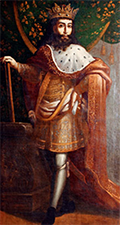King Pedro I of Portugal
Pedro I was King of Portugal for a decade in the mid-14th Century. His love for his second wife was one of history's great love stories. He was born on April 8, 1320. His father was Afonso, the oldest son of the reigning monarch, Dinis. Afonso became king when his father died, in 1325, and Pedro became the heir apparent. 
In 1340, Pedro married Constanza of Castile. They had two children who lived into adulthood: Maria (1342) and Ferdinand (1345). Constanza died the year that Ferdinand was born. Pedro then declared his intention to pursue a relationship with another woman with whom he had fallen madly in love. Her name was Inês de Castro; she had been Constanza's lady-in-waiting, and she had a powerful family in Galicia. 
Pedro, defying his father's wishes, went to live with Inês, married her in 1354, and they had four children together, three of whom lived into adulthood: John (1352), Denis (1353), and Beatrice (1354). Rumors came to King Afonso that his son had fallen under the influence of Inês and her family and was planning to revolt, and the king ordered her imprisoned. Whether at the king's orders or not, a group of men killed Inês. Pedro then did revolt against his father. The rebellion lasted nearly two years before father and son reconciled. Not long afterward, Afonso died, on May 28, 1357. Pedro then became king. Shortly after taking the throne, the new king set about trying to arrest the men who had killed Inês. He was somewhat successful and had those he caught executed. Pedro then gave Inês a funeral fit for a queen and had a marble tomb built for her. Pedro focused on maintaining peace with his neighbors, and he did so, at one point supporting Castile in its struggle with Aragon. Pedro also (by a 1361 summoning of the Cortes) succeeded in increasing the king's power at the expense of the Catholic Church, requiring church leaders to gain his approval before issuing papal bulls, or pronouncements. The king also did his father one better, keeping the nobles on side through all of that. He also reformed the judicial system, leading to his appellation as Pedro the Just. With his kingdom at peace, Pedro died, on Jan. 18, 1367. His oldest son, Ferdinand, succeeded him on the throne. The love story of Pedro and Inês has been the subject of countless poems, tales, and (in more recent years) films.
|
|
Social Studies for Kids
copyright 2002–2026
David White




